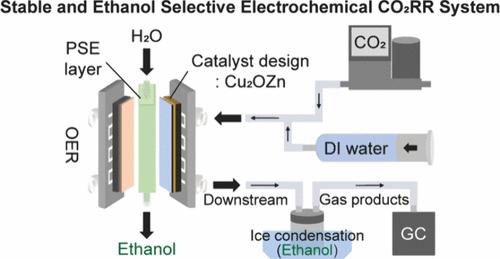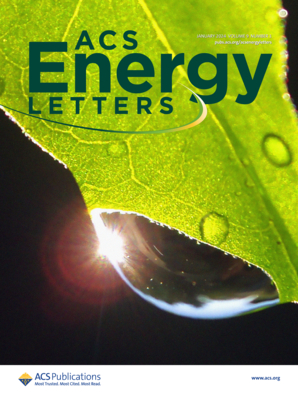Selective and Stable Ethanol Synthesis via Electrochemical CO2 Reduction in a Solid Electrolyte Reactor
IF 18.2
1区 材料科学
Q1 CHEMISTRY, PHYSICAL
引用次数: 0
Abstract
Electrochemical CO2 reduction to ethanol faces challenges such as low selectivity, a product mixture with liquid electrolyte, and poor catalyst/reactor stability. Here, we developed a grain-rich zinc-doped Cu2O precatalyst that presented a high ethanol Faradaic efficiency of over 40% under a current density of 350 mA·cm–2. Our density functional theory (DFT) simulation suggested that Zn atoms inside the structure have a greater carbophilicity than the Cu atoms to help facilitate *CHCHO formation, a key reaction intermediate toward ethanol instead of other C2 products. A high Faradaic efficiency ratio between ethanol and ethylene (FEEtOH/FEC2H4) reached 2.34 in the zinc-doped Cu2O precatalyst, representing an over 4-fold improvement compared to bare Cu2O precatalyst. By integrating this Cu-based catalyst into a porous solid electrolyte (PSE) reactor with a salt-managing design, we achieved stable ethanol production for over 180 h under a current density of 250 mA·cm–2 while maintaining ethanol selectivity at ∼30%.

固体电解质反应器中电化学CO2还原选择性稳定乙醇合成
电化学CO2还原为乙醇面临着选择性低、产物与液体电解质混合以及催化剂/反应器稳定性差等挑战。在此,我们开发了一种富含晶粒的锌掺杂Cu2O预催化剂,在350 mA·cm-2的电流密度下,乙醇法拉第效率高达40%以上。我们的密度泛函理论(DFT)模拟表明,结构内部的Zn原子比Cu原子具有更大的亲碳性,有助于促进*CHCHO的形成,而*CHCHO是生成乙醇的关键反应中间体,而不是其他C2产物。在掺杂锌的Cu2O预催化剂中,乙醇和乙烯的法拉第效率(fetoh /FEC2H4)达到2.34,比纯Cu2O预催化剂提高了4倍以上。通过将这种cu基催化剂集成到具有盐管理设计的多孔固体电解质(PSE)反应器中,我们在250 mA·cm-2的电流密度下实现了180小时的稳定乙醇生产,同时将乙醇选择性保持在30%左右。
本文章由计算机程序翻译,如有差异,请以英文原文为准。
求助全文
约1分钟内获得全文
求助全文
来源期刊

ACS Energy Letters
Energy-Renewable Energy, Sustainability and the Environment
CiteScore
31.20
自引率
5.00%
发文量
469
审稿时长
1 months
期刊介绍:
ACS Energy Letters is a monthly journal that publishes papers reporting new scientific advances in energy research. The journal focuses on topics that are of interest to scientists working in the fundamental and applied sciences. Rapid publication is a central criterion for acceptance, and the journal is known for its quick publication times, with an average of 4-6 weeks from submission to web publication in As Soon As Publishable format.
ACS Energy Letters is ranked as the number one journal in the Web of Science Electrochemistry category. It also ranks within the top 10 journals for Physical Chemistry, Energy & Fuels, and Nanoscience & Nanotechnology.
The journal offers several types of articles, including Letters, Energy Express, Perspectives, Reviews, Editorials, Viewpoints and Energy Focus. Additionally, authors have the option to submit videos that summarize or support the information presented in a Perspective or Review article, which can be highlighted on the journal's website. ACS Energy Letters is abstracted and indexed in Chemical Abstracts Service/SciFinder, EBSCO-summon, PubMed, Web of Science, Scopus and Portico.
 求助内容:
求助内容: 应助结果提醒方式:
应助结果提醒方式:


